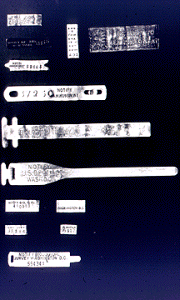
Received an email today to request that we be on the lookout for Loggerhead Shirkes that are banded. All the information is below. One was actually spotted in last year's Christmas Bird in Somerset, Kentucky. They are asking this year that any sightings at any time with the bands be reported. Bird banding is a critical part of the geographical data of habitat and breeding grounds of birds that are being effected by loss of critical forest lands and the everyday urban and rural spread of homes and businesses. Below is a brief history of banding and it's effectiveness in recording decline and increase of bird populations. If you were to spot a loggerhead shrike or have questions about a bird you are having trouble identifying, please give us a call at (606) 330-0606. We would be pleased to help in any way.
A Brief History of Bird Banding
People have been banding (or ringing, as it is called in Europe) birds for centuries. The first record of a metal band attached to a bird's leg was about 1595 when one of Henry IV's banded Peregrine Falcons was lost in pursuit of a bustard in France. It showed up 24 hours later in Malta, about 1350 miles away, averaging 56 miles an hour!
Duke Ferdinand placed a silver band on a Grey Heron about 1669: the bird was recovered by his grandson about 1728, indicating the heron lived at least 60 years. In 1710 in Germany, a falconer captured a grey heron with several rings on one leg. The bander was unknown but one of the rings was apparently placed on the heron in Turkey, more than 1200 miles to the east.
The first records of banding in North America are those of John James Audubon, the famous American naturalist and painter. In 1803 he tied silver cords to the legs of a brood of phoebes near Philadelphia and was able to identify two of the nestlings when they returned to the neighborhood the following year.
A system for bird banding did not really develop until 1899, when Hans Mortensen, a Danish school teacher, began placing aluminum rings on the legs of European teal, pintail, white storks, starlings and several types of hawks. He inscribed the bands with his name and address in the hope they would be returned to him if found. His system of banding became the model for our current efforts.
In 1902
Paul Bartsch, a well-known conchologist whose hobby was the study of birds, began the first scientific system of banding in North America. In that year he ringed more than 100 black-crowned night herons in the District of Columbia with bands inscribed "Return to Smithsonian Institution". The real pioneer bander in the Americas was Jack Miner who established a waterfowl sanctuary near Kingsville, Ontario. Between 1909 and 1939 he banded 20,000 Canada Geese alone, many of which carried bands returned to him by hunters
By 1909 the American Bird Banding Association had been formed to organize and assist the growing numbers. In 1920 the Bureau of Biological Survey and the Canadian Wildlife Service accepted the offer to jointly take over the work of the Association.
Frederick Lincoln was assigned the task of organizing the banding program in the USA in the Bureau of Biological Survey (now the United States Geologic Survey). The North American banding program has been a joint effort to oversee the activities of dedicated banders all over the world ever since.
More on the first 100 years of banding in North America
REQUEST
Much time and effort has been put into Loggerhead Shrike research and recovery in Ontario, Canada, where the species is critically endangered. Breeding shrikes found in Ontario are banded with metal and/or colour leg bands in an effort to address the greatest knowledge gap for recovery of Ontario shrikes -- migration routes and wintering areas.
We are asking for your help by alerting all your CBC volunteers to determine if any Loggerhead Shrikes they find are banded. Please ask your CBC volunteers to report BANDED Loggerhead Shrikes sightings to Wildlife Preservation Canada:jessica@wildlifepreservation.ca. Of greatest importance are shrikes banded with ONLY a red band over silver on the left leg, OR silver band on right leg and red band on left leg -- these birds are carrying 'geolocator' tags and must be captured to retrieve the tag, which will provide information on their migration route. Please forward this email to any birders or birding organizations (newsletters, birding list serves, ornithological societies and clubs, etc.) which may be of assistance in locating BANDED wintering Loggerhead Shrikes.
We have provided more information about the recovery programme, banding colour coding and the reporting of sightings in the attached file. Please feel free to forward this information to others.
Thank you for your assistance.
Dan Bone, Wildlife Preservation Canada (volunteer), 705-887-4691, http:///, Fenelon Falls, Ontario, Canada **********************************


